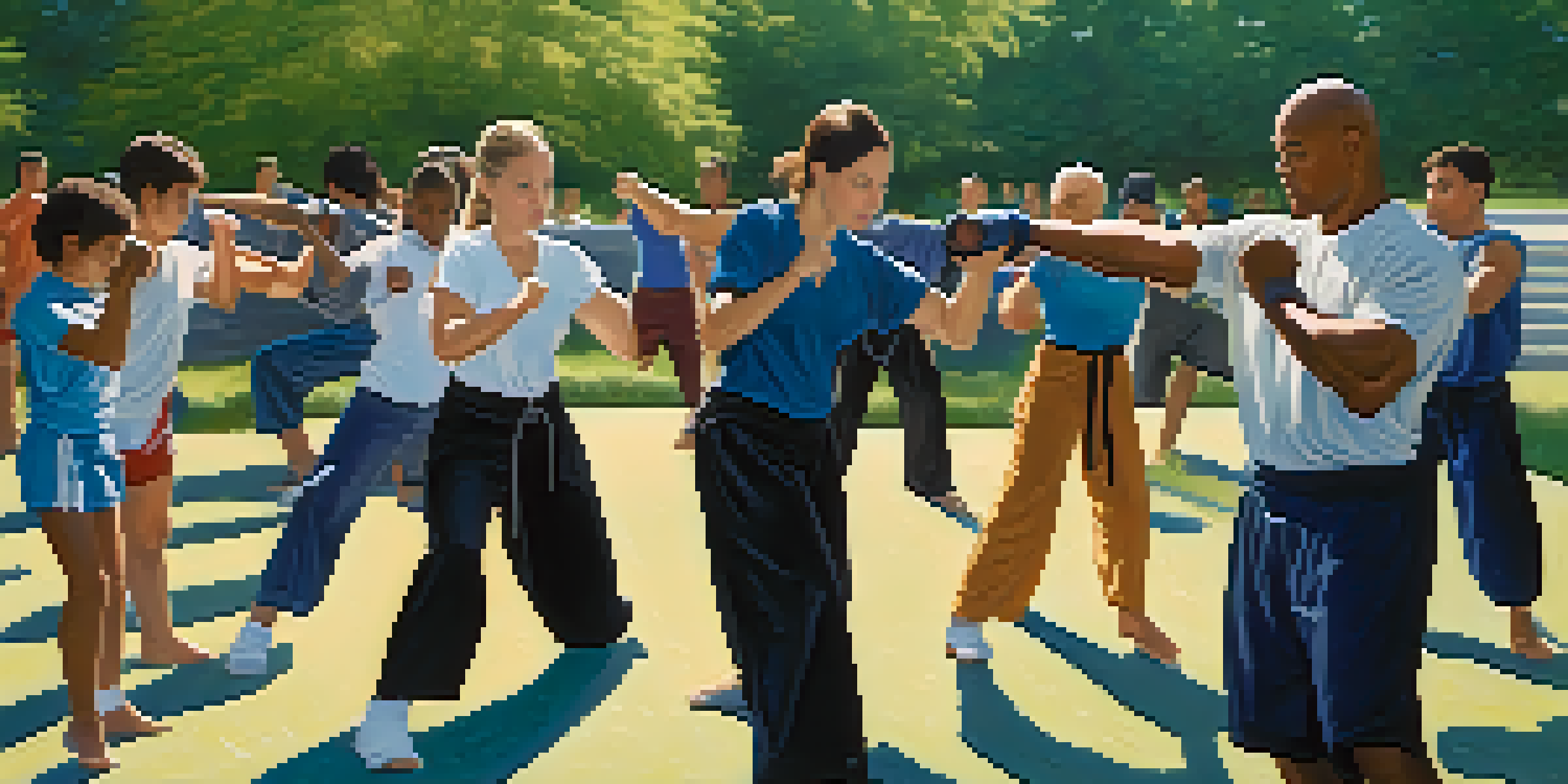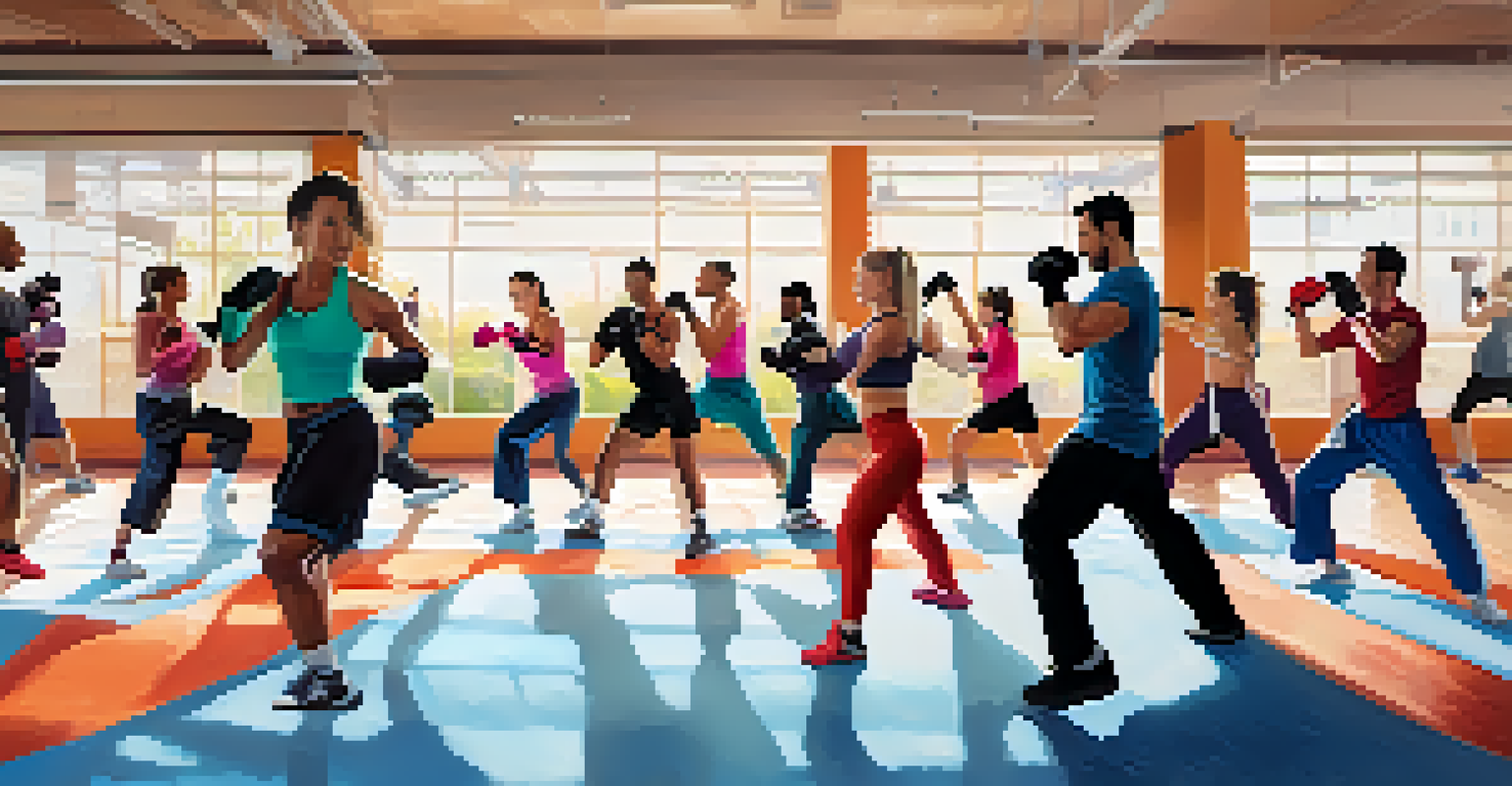Top 10 Exercises to Boost Your Self Defense Abilities

Why Self-Defense Training is Essential for Everyone
Self-defense training is not just for martial artists or law enforcement; it's a crucial skill for everyone. In today’s unpredictable world, having the ability to protect yourself can bring peace of mind and confidence. It’s about more than just physical strength; it’s also about mental preparedness and awareness of your surroundings.
The best defense is a good offense.
When you engage in self-defense training, you learn to assess situations quickly and react appropriately. This not only helps in physical confrontations but also fosters a sense of empowerment in everyday life. Plus, it can be a fun and engaging way to stay active!
Ultimately, self-defense is about being proactive rather than reactive. By training regularly, you equip yourself with the knowledge and skills necessary to handle potentially dangerous situations, making it a vital practice for people of all ages.
1. Shadow Boxing: The Basics of Movement
Shadow boxing is an excellent way to develop your footwork, speed, and technique without a partner. It allows you to practice punches, kicks, and defensive moves in a fluid manner. As you visualize an opponent, you can work on your timing and rhythm, which are essential in any self-defense situation.

This exercise can be done anywhere, requiring no special equipment, making it accessible for everyone. It encourages you to stay light on your feet and improves your overall agility. Plus, it’s a great cardiovascular workout that helps build endurance.
Self-Defense Training for Everyone
Self-defense training equips individuals with essential skills for protection and fosters confidence in everyday situations.
To get the most out of shadow boxing, focus on your form and incorporate various techniques. Think of it as a dance where you’re both the dancer and the opponent, helping you refine your skills while staying active.
2. Push-Ups: Building Upper Body Strength
Push-ups are a classic exercise that targets your chest, shoulders, and triceps, which are crucial for effective self-defense techniques. Strong upper body muscles can help you push away an attacker or deliver powerful strikes. Additionally, push-ups can enhance your core strength, critical for stability in any physical confrontation.
Self-defense is not just a skill, it's a mindset.
There are many variations of push-ups to keep things interesting and challenging. From incline push-ups to diamond push-ups, each variation targets different muscle groups. This variety can help prevent boredom and keep you motivated to train regularly.
Incorporating push-ups into your routine not only builds strength but also improves your overall fitness level. This foundational exercise is simple yet incredibly effective in enhancing your self-defense capabilities.
3. Squats: Strengthening Your Legs and Core
Squats are an essential exercise for building leg and core strength, vital for any self-defense maneuver. Strong legs allow you to maintain balance and stability while defending yourself or escaping a situation. Moreover, a solid core helps with power generation for strikes or throws.
Performing squats can be done in various forms, such as bodyweight squats, jump squats, or goblet squats. This versatility means you can easily adapt your workout to suit your fitness level and preferences. Plus, squats can enhance your overall athletic performance.
Variety of Exercises Enhances Skills
Incorporating diverse workouts like push-ups, squats, and kickboxing keeps training engaging while improving strength and agility.
To maximize the benefits, focus on proper form and gradually increase your repetitions or weights. Not only will your self-defense skills improve, but you’ll also see improvements in your overall strength and fitness.
4. Grappling Drills: Practicing Real-Life Scenarios
Grappling drills simulate real-life scenarios, helping you learn how to control an opponent effectively. These exercises often include techniques like takedowns, holds, and escapes, all of which are crucial in self-defense situations. Practicing these movements can boost your confidence and ability to react under pressure.
Working with a partner during grappling drills allows you to experience different body types and sizes, preparing you for various encounters. It also teaches you how to maintain composure when someone else is trying to overpower you. This practical experience is invaluable in self-defense training.
Even if you don't have a partner, you can practice solo grappling techniques or use a dummy. The key is to focus on technique and muscle memory, ensuring you’re ready to respond when it matters most.
5. Kickboxing: Combining Fitness with Defense Skills
Kickboxing is a dynamic workout that combines martial arts techniques with high-intensity cardio. It’s a fantastic way to develop your striking skills while improving your stamina and overall fitness. The combination of punches and kicks engages multiple muscle groups, making it a comprehensive workout.
Engaging in kickboxing not only builds physical strength but also sharpens your reflexes and coordination. Learning to throw effective strikes can be crucial in self-defense situations where speed and precision matter. Plus, the upbeat music and group classes make it a fun and social workout.
Consistency is Crucial for Success
Regular practice in self-defense techniques is key to building muscle memory and ensuring preparedness for potential threats.
Whether you join a class or follow online workouts, kickboxing is an engaging way to boost your self-defense abilities while getting fit. Embrace the challenge and enjoy the journey toward becoming more empowered!
6. Resistance Training: Enhancing Overall Strength
Incorporating resistance training into your routine is essential for building the strength needed for self-defense. Exercises like deadlifts, bench presses, and kettlebell swings can significantly enhance your muscular power and endurance. This increased strength can help you effectively defend yourself against an attacker.
Resistance training also improves your bone density and metabolic rate, contributing to overall health. As you build muscle, you’ll notice enhanced performance in other physical activities too. It’s a win-win situation!

To get started, consider using free weights, resistance bands, or even your body weight. Focus on compound movements that engage multiple muscle groups for the best results, ensuring you’re well-prepared for any self-defense scenario.
7. Flexibility Training: Staying Agile and Evasive
Flexibility training is often overlooked but is crucial for effective self-defense. Improved flexibility allows for better movement and agility, enabling you to evade attacks and react quickly. Incorporating stretches and mobility exercises can enhance your range of motion, making you more unpredictable in a confrontation.
Yoga and dynamic stretching routines are excellent ways to improve flexibility. These practices not only enhance your physical capabilities but also promote relaxation and mental clarity. This combination can be beneficial during high-stress situations, helping you maintain composure.
By prioritizing flexibility training, you can significantly enhance your self-defense techniques and overall physical performance. It’s an essential piece of the puzzle that complements strength and agility.
8. Consistency is Key: Making Self-Defense a Habit
To truly boost your self-defense abilities, consistency in training is crucial. Like any skill, regular practice helps reinforce techniques and builds muscle memory. Set aside dedicated time each week to engage in various exercises, ensuring you're always improving and staying prepared.
Mixing different types of workouts—like strength training, cardio, and flexibility exercises—keeps your routine fresh and exciting. This variety not only prevents boredom but also ensures you're developing a well-rounded skill set for self-defense.
Remember, self-defense is a journey, not a destination. Embrace the process, celebrate your progress, and commit to making self-defense training a regular part of your life. With dedication and consistency, you’ll be well-equipped to handle any situation that may arise.